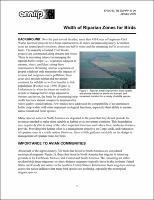Please use this identifier to cite or link to this item:
https://hdl.handle.net/11681/4015| Title: | Width of riparian zones for birds |
| Authors: | Fischer, Richard A., Jr., 1964- |
| Keywords: | United States. Army. Corps of Engineers Riparian areas--United States--Management Birds Riparian areas |
| Publisher: | Engineer Research and Development Center (U.S.) |
| Series/Report no.: | Technical Note (Ecosystem Management and Restoration Research Program (U.S.)) ; no. ERDC/EL TN-EMRRP-SI-09 |
| Abstract: | Over the past several decades, more than 450 Corps of Engineers Civil Works reservoir projects have been constructed in 43 states encompassing nearly 12 million acres (at normal pool elevations, about one half is water and the remaining half is associated land). The majority of inland Civil Works projects are constructed along streams and rivers. There is increasing interest in managing the riparian buffer strips (i.e., vegetation adjacent to streams, rivers, and lakes) along these watercourses. Retaining riparian vegetation of proper width not only minimizes the impacts of erosion and nonpoint-source pollution; these areas also provide habitat and movement corridors for wildlife as well as benefits to fish populations (Fischer et al. 1999) (Figure 1). Unfortunately, when decisions are made to restore or manage buffer strips adjacent to streams and rivers, the basis for determining strip width has been almost completely dominated by water quality considerations. Few studies have addressed the compatibility of recommended buffer strip widths with other important ecological functions, especially their ability to sustain native faunal and floral species. Many riparian zones in North America are degraded to the point that they do not provide the resources needed to make them suitable as habitat or as movement corridors. This degradation also negatively affects many of the other important functions and values these landscape features provide. Providing bird habitat often is a management objective on Corps lands, and restoration of riparian zones is a viable option. However, there is little guidance available on the design or management of riparian zones for birds. |
| Description: | Technical Note |
| Gov't Doc #: | ERDC/EL TN-EMRRP-SI-09 |
| Rights: | Approved for public release; distribution is unlimited |
| URI: | http://hdl.handle.net/11681/4015 |
| Appears in Collections: | Technical Note |
Files in This Item:
| File | Description | Size | Format | |
|---|---|---|---|---|
| ERDC-TN-EMRRP-SI-09.pdf | 489.95 kB | Adobe PDF |  View/Open |